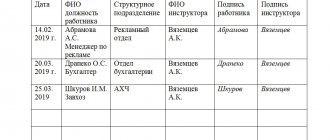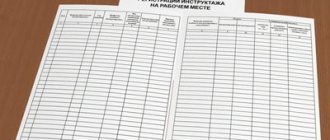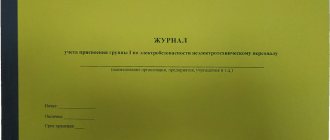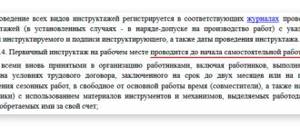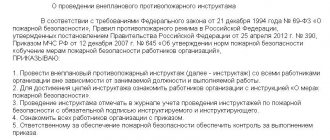What is induction training and what is the purpose of it?
Purpose of induction training
After an interview with the employer and a medical examination, a citizen must undergo an introductory safety briefing before visiting the workplace. It is usually carried out by an occupational safety specialist appointed by the manager by order.
The objectives are as follows:
- inform the employee of the work and rest regulations (what time the working day begins, what time it ends, when time is provided for a lunch break and rest breaks during the work shift);
- tell what rules must be followed while on the territory;
- highlight the basics of labor legislation relating to this object;
- warn what dangerous areas exist on the territory;
- tell the rules for walking and staying on site;
- explain what personal protective equipment the employee should use when performing general work;
- warn what dangers exist;
- teach the basics of fire safety, including how to properly use primary fire extinguishing equipment.
And other circumstances specific to a particular enterprise.
What is needed for induction training
To conduct an introductory briefing, a specialist needs to prepare a summary so that everything is described in detail.
In addition, you must have:
- Regulations for conducting induction training. The document is prepared by specialists of the labor protection service, then undergoes a legal examination, is agreed upon with interested parties, a reasoned opinion of the chairman of the primary trade union organization is attached to it, and then the local act is approved by the head of the organization. The Regulations reflect everything related to induction training, including the preparation of notes.
- An induction training program agreed upon by the head of the labor protection department and approved by the manager.
- The classroom for conducting instruction must be equipped with posters, stands, samples of personal protective equipment and special clothing, a projector with videos and other equipment.
- An induction training log must be kept, since all future employees of the enterprise must sign in a certain column. The document must be bound and numbered.
- To conduct an introductory briefing on occupational safety, it is recommended to simultaneously invite a representative of the fire department so that the latter can conduct an introductory briefing on fire safety.
Introductory training on labor protection
Induction training is the first, basic training that new employees undergo when applying for a job. Today we will tell you who, when and how this instruction should be carried out so that it is as effective as possible and does not cause comments from the GIT inspector.
Lesson No. 1 - who conducts the induction training?
Introductory training on labor protection in the organization is carried out by a labor protection specialist. Also, the manager can assign this responsibility by order to an employee who has been trained and tested as an occupational safety instructor in one of the accredited training centers (clauses 2.1.2 and 2.3.2 of the Training Procedure, approved by Resolution of the Ministry of Labor dated January 13, 2003 No. 1 /29.
Question : There are companies that do not have a position of occupational safety specialist or an employee designated for this purpose. What to do in this case?
Answer : In such companies, induction training should be carried out by the manager himself. According to the law, he is the person responsible for labor protection at the enterprise. And if there is no full-time labor protection specialist, his functions are performed by the employer (Article 217 of the Labor Code of the Russian Federation).
Important! If an employer has not been trained and tested for knowledge of labor safety requirements at a training center, they do not have the right to conduct induction training, and therefore not hire new employees.
Lesson No. 2 - with whom to conduct induction training
The occupational safety specialist conducts this briefing with all persons entering work, as well as with everyone who needs to be allowed to work in the company. You will find an exhaustive list in clause 2.1.2 of the Labor Safety Training Procedure, approved. Resolution of the Ministry of Labor and Ministry of Education dated January 13, 2003 No. 1/29.
Such persons include:
- newcomers who are hired into the organization;
- posted workers;
- employees of other companies who work in a dedicated area in your organization;
- students undergoing practical training in your organization;
- other persons who participate in the production activities of the organization.
Important! None of the listed employees should be allowed to work without undergoing induction training.
Lesson No. 3 - how to conduct induction training
To ensure that the introductory briefing procedure does not raise any questions for you, use a simple step-by-step algorithm .
Step 1 . An employee appears in the organization, with whom, by law, it is necessary to conduct induction training.
Step 2 . The occupational safety specialist or responsible person invites the employee to the occupational safety office or other suitable premises.
Step 3 . Based on the induction program developed by the organization, the occupational safety specialist conducts training.
Step 4 . During the briefing, the employee is told about the company’s rules of conduct and the principles of safety in the premises and on its territory. It is necessary to convey the rules of electrical and fire safety. If there are harmful and dangerous production factors at the enterprise, it is imperative to convey complete information to the employee. We must not forget about the personal protective equipment and collective protective equipment that the company uses, etc. Include in your training all the nuances about the specifics of production that an employee needs to know in order to protect him from possible accidents in the future.
Step 5 . Conduct a verbal survey to check how well the employee has understood the information they received during orientation.
Step 6 . After testing your knowledge, record the induction training in the induction training log: enter the date, details of the employee, his position and department, be sure to indicate the details of the employee who conducted the training and put your signatures.
Novice occupational safety specialists often make mistakes during induction training. An expert from the Qualification and Training Assessment Center No. 1 will tell you about the 5 main mistakes and give useful recommendations.
What does the Training Program cover?
Induction program: main provisions
Based on GOST requirements, enterprises and organizations must develop induction training programs. This requirement is mandatory. The program must take into account the following points:
- general safety requirements (information about the organizational structure itself, the specifics of the work and the presence of dangerous objects);
- fundamentals of labor legislation regulating the implementation of basic norms and rules;
- how the labor protection system is organized at the enterprise;
- what rules of conduct must be followed;
- actions in case of accidents, including the basics of providing first aid to victims;
- what PPE and RPE should be used;
- what emergency situations are possible and what the employees should do;
- about fire safety.
A certain time is allocated for the story of each point, which is also indicated in this Program. The document may also contain links to labor safety instructions in force at the enterprise.
Order
Instruction of personnel is carried out using forms specially designed for this purpose. The following documents are used in the process.
Instructions
The presented manuals can be created for a specific type of work performed separately and entirely for the entire organization. When creating, industry safety rules are applied using safety requirements, documentary samples and technological documentation of the enterprise whose equipment is used.
Important! The basis for creating instructions is the director's order.
Program
It is the main document regulating the introductory orientation of the arriving employee. The law states that in a company such a document can be in free form. There is no need to use a single sample. However, the submitted documents should pay attention to specific aspects of the company's activities.
Such a document is not difficult to draw up and execute. It is a simple list of facts and points that should be conveyed to the arriving person. It also regulates the amount of time that should be spent on each of the questions during instruction.
Sample program
The standard program is not an independent document, but is an appendix to the main order. The order itself is first drawn up and executed, which must be familiarized with by the occupational safety instructor. He should confirm the order with his signature.
Who should receive the induction training?
Induction training is mandatory for all persons who need to enter the facility, namely:
- with permanent employees hired by the enterprise;
- with temporary categories of workers who will carry out labor activities during any period;
- with students;
- with a business traveler;
- with hygiene workers;
- with other persons.
Why should induction training be carried out for literally everyone? This is due to the fact that on the territory of the enterprise there are various production facilities that involve the use of lifting mechanisms, equipment operating under excess pressure and other hazards.
In other words, the territory of the enterprise is not a walking park and you can’t just walk around there without knowing the essential nuances. And, despite the high-quality introductory briefing, new employees or persons who find themselves on the territory of the enterprise must be accompanied, and as accompanying persons, as a rule, responsible employees or heads of departments are assigned.
How is it carried out?
It is carried out by a responsible person in an office specially created for this purpose, which must have all the necessary visual aids and examples. The person being instructed becomes familiar with the developed instructions and manuals. All issues listed must be examined within the given time period.
After this, a special journal entry is created stating that the person arriving for work has studied all the documents. It contains the signatures of all persons who took part in the briefing. Then the employment documentation is filled out.
The employee is sent to the workplace and, if provided, undergoes initial instruction by his immediate supervisor.
Logbook
Sample Induction Journal
Filling out the induction briefing log
The form of the briefing log can be developed at the enterprise and approved by a local act. To reproduce a document, it is enough to place an order at a printing house. The Journal looks like this:
The name of the organization is written on the title page in the upper right corner. In the center of the page it is written: “Introductory briefing registration log”, and at the bottom right there are lines for the start and end dates of maintaining the document.
In the main part the columns are filled in:
- serial number;
- the date of the;
- surname and initials of the person being instructed;
- year of birth of the person being instructed;
- Job title;
- subdivision;
- surname and initials of the instructing person;
- signatures of both parties.
Each column must be completed, and the entries made in it must be legible. The induction training is also recorded in the employee’s personal card.
The document is stored at the enterprise for at least 10 years, then the Journal is destroyed in accordance with the instructions for office work.
Who can conduct induction training?
A labor protection specialist has the right to conduct introductory training. To do this, the following must be observed:
- The employee must be appointed by order of the manager.
- The employee himself must be certified in labor protection and the validity period of the certificate must not be expired.
- The instruction must be conducted in a specially equipped classroom. The employer also has the right to engage a specialist from a third-party organization to conduct training on a contractual basis.
Types of labor safety briefings
Occupational safety briefings are part of the occupational safety training system and testing knowledge of occupational safety requirements in any organization.
At the legislative level, 5 types of occupational safety briefings , which must be carried out with employees in different situations (clauses 2.1.1 and 2.1.3 of the Labor Safety Training Procedure, approved by Resolution of the Ministry of Labor and Ministry of Education dated January 13, 2003 No. 1/29) .
Some of them are mandatory, the rest must be carried out with certain personnel in situations specified by law.
- Induction training . This is the first type of instruction that is carried out with EVERY employee who participates in the production activities of the organization. This must be done before he starts work at his workplace.
- Initial briefing . This is the second type of instruction that is given to employees before they are allowed to work independently. The law allows the employer to conduct it not with all employees. But only with those who are directly involved in the production activities of the organization. For example, electrician, installer, operator, etc. The employer has the right to exempt certain categories of personnel from initial training. These could be employees whose work involves exclusively using a PC, for example, administrators, secretaries, managers, accountants. But even here there are pitfalls, which we will definitely discuss in detail in the next article .
- Re-instruction . This type of training is carried out with those employees who have undergone initial training. This is done once every six months, for some categories - once every 3 months. The goal is to continually reinforce and update information about safe practices and practices in the workplace.
- Unscheduled . This type of instruction is not tied to any specific mandatory period. It is carried out as necessary. All reasons are stated in Training Procedure 1/29. We will also definitely talk about this in detail in our materials .
- Targeted instruction . Like unscheduled training, targeted training is also not carried out with any regularity, but only in those cases specified in Training Procedure 1/29.
Useful table on types of labor safety briefings
Regulatory document on conducting briefing
Instructions for conducting induction training
For convenience in work, it is worth publishing instructions for conducting induction training. It is approved by the administrative document of the enterprise. The preparation of the project is carried out by occupational safety specialists, and other workers may also be involved: medical workers, firefighters, and a trade union must also be involved.
Recommended contents of the instructions:
- General provisions or a list of the main topics that are covered during the briefing.
- Basic information. Here, each of the topics is covered separately, that is, it will be convenient when conducting a conversation with employees or work colleagues.
- What regulatory documentation was used to prepare the instructions.
If changes are made to the legislation, then changes must also be made to the instructions. This instruction is reviewed every five years, and if necessary, this period is reduced.
